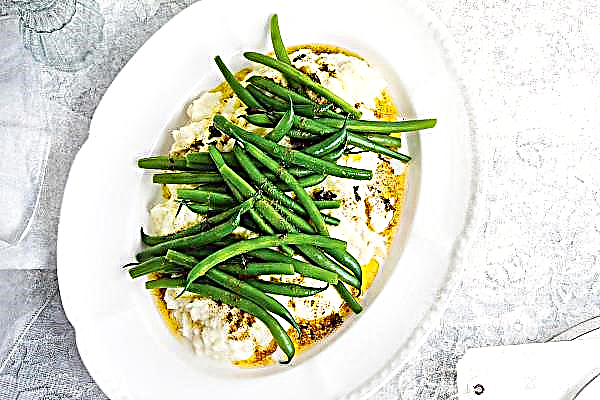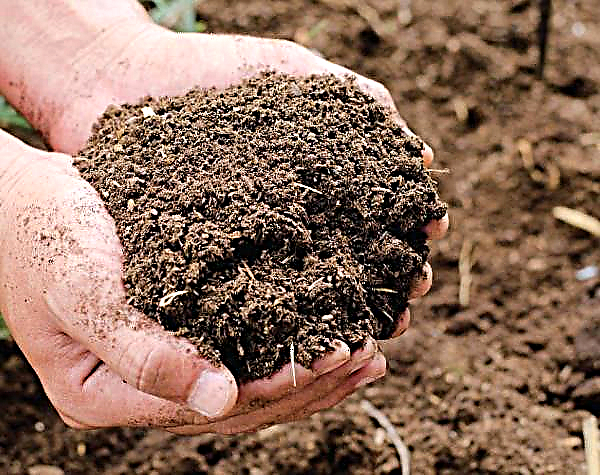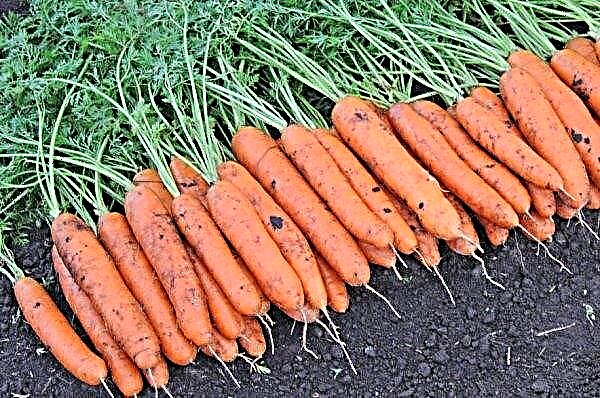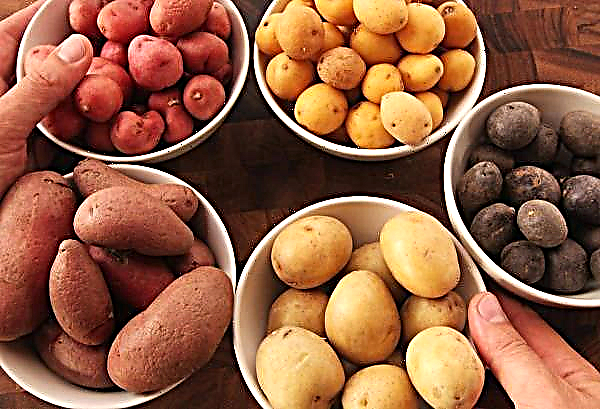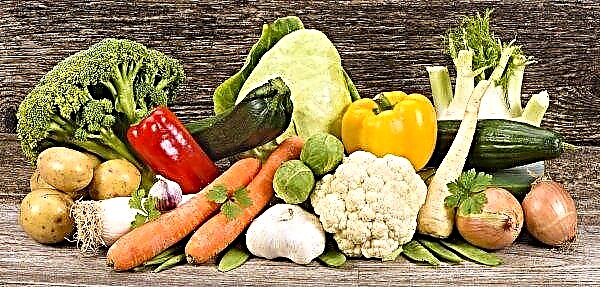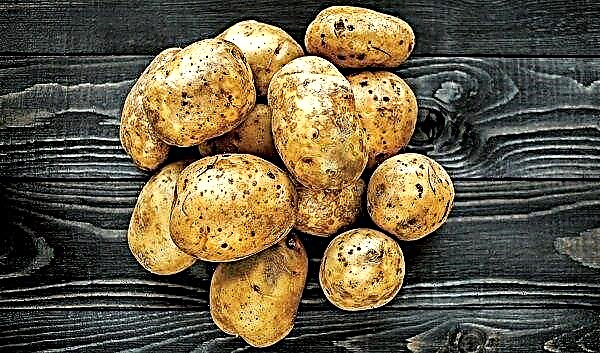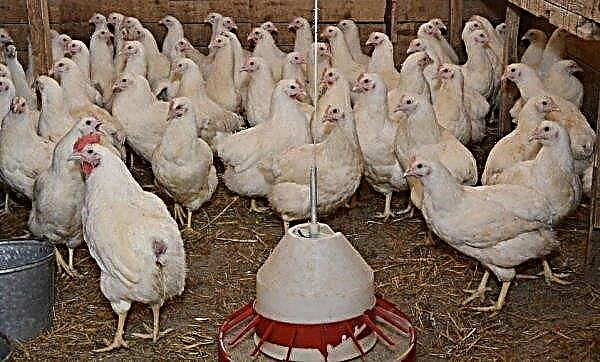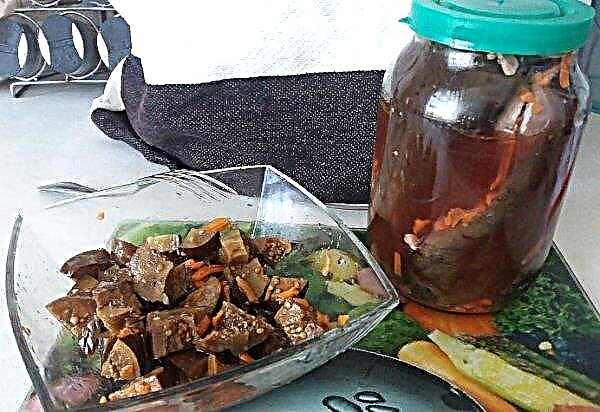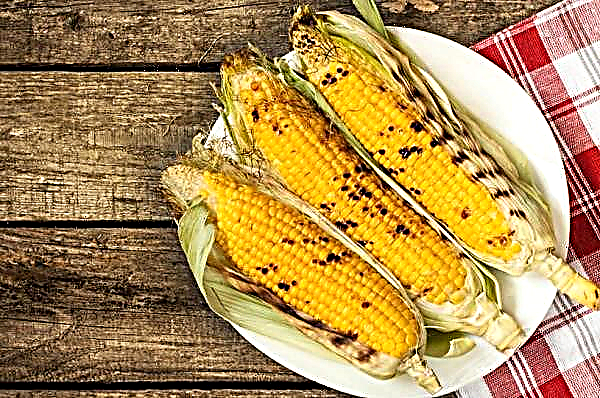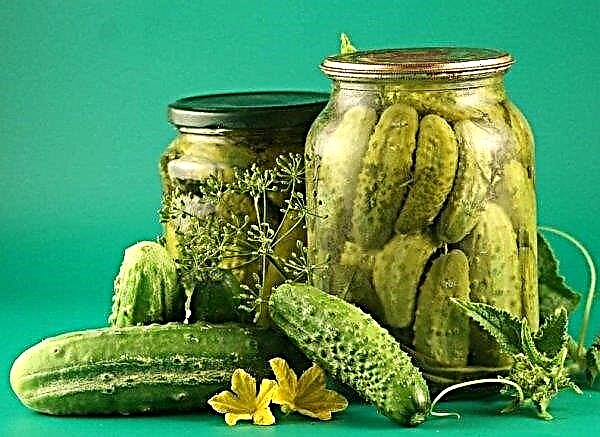Czech brown dairy goats are popular with small and large farmers, they are relatively easy to care for, animals are unpretentious in feed, and also do not require much space for maintenance. In this article we will take a closer look at the description and characteristics of this breed, learn how to care for goats and how to breed them.
Origin
Czech brown shorthair goat is a breed obtained as a result of breeding work carried out from 1900 to 1930. Her ancestors are Czech Garz goats, Swiss and brown alpine goats.
Did you know? Goats have a stomach, consisting of four sections (scar, mesh, books and abomasum). Their food first falls into the scar, then moves into the net, then falls into the book and, at the end of the path, passes into the abomasum, which most closely resembles a sensitive human stomach.
General characteristics of the breed
These goats are short-haired, with brown fur color and thick undercoat. Most of the representatives of this breed do not have horns; 80% of the livestock have a pronounced kolost. The heads of only 20% of Czech brown goats are crowned with thick, slightly curved back horns. The milk yield of the females is very high.
Description of appearance
Medium sized animals with a muscular physique.
Goats are very hardy, adapt well to climatic conditions and content.| Average carcass weight, kg | Goats - 75–80, goats - 50–55 |
| Impassability | In 80% of cases |
| The presence of horns | In 20% of cases |
| Color | Brown, with a darker strip on the ridge |
| Height at withers, cm | Males - 75–85, females - 70–75 |
| Chest circumference, cm | Males - 90–110, females - 80–100 |
| Tail | Short |
| Beard | Only goats, black |
| The ears | Rounded, small. |
Productive qualities
It is beneficial to keep Czech short-haired goats in both small and large farms. For most of the year, dairy goats supply their owners with milk.
Fattening animals after slaughter give a good meat yield with a small amount of fat, as well as soft and warm skins, strong skin suitable for sewing clothes and shoes, wool for knitting sweaters and mittens.
Milk yield
Czech goats every day delight owners with moderately fat, thick and very healthy milk. After the first lambing of a young goat, it is already possible to milk up to one and a half liters of milk daily. Milk from an adult goat is from 4 to 6 liters. The recorded record of milk yield of the Czech brown shorthair goat for 12 months is 2600 liters of moderately fat milk.
The recorded record of milk yield of the Czech brown shorthair goat for 12 months is 2600 liters of moderately fat milk.
Characteristics of Czech brown milk:
- fat content of milk - from 3.5 to 4.5%;
- protein in milk - from 2.7 to 3%;
- lactose in milk - 5%;
- average milk yield - 900 liters per year;
- the average lactation period is 300 days.
The taste of milk in goats of this breed is unobtrusively creamy. Czech milk comes on sale already pasteurized; cheeses, cottage cheese and feta cheese are also made from it. Due to its excellent digestibility, Czech milk is suitable for baby food without causing allergies.
Did you know? Incredibly soft and expensive cashmere made from fluffy winter undercoat of Kashmiri goats. The price of cashmere is very high, since manually separating the silky undercoat from the coarse goat hair is a laborious process. In order to make a sweater for an adult, an undercoat of two adult animals of this breed is required.
Meat
After slaughtering young six-month-old kids, the net meat yield is within 20 kg, at the age of one year, from 40 to 45 kilograms. The older the goat, the greater the yield of meat; it is most rational to slaughter animals at the age of one and a half years. Previously, the goat is specially fattened.
The brown shorthair Czech goats have the following meat characteristics:
- the average weight of a live carcass is 52 kg;
- weight after slaughter - 24.2 kg, of which: fat - 3.8 kg, meat - 20.4 kg.
- yield in percentage terms - 46.6%.
 The meat of one-year-old and half-year-old kids is soft, not fibrous, in tenderness and taste it is very similar to the meat of young calves. The color of goat meat differs from lamb in a lighter shade, but it is much darker than veal. Goat fat is white, not as much as in a lamb carcass.
The meat of one-year-old and half-year-old kids is soft, not fibrous, in tenderness and taste it is very similar to the meat of young calves. The color of goat meat differs from lamb in a lighter shade, but it is much darker than veal. Goat fat is white, not as much as in a lamb carcass.Goat meat has its own specific flavor, not all people love it. Therefore, at a young age, males are castrated, and shortly before the start of cooking, the goat meat is kept in acid marinades (wine, vinegar) with spices, for at least 24 hours.
In order to cook goat meat deliciously, it is fried over an open fire, stewed, baked with vegetables or cereals in the oven.
Did you know? Goats have rectangular pupils, their unusual shape gives animals a more complete spectrum of vision than humans and animals with round pupils. With peripheral vision, goats can capture a panorama from 320 to 340 degrees - this property is very useful for preventing predator attacks. The drawback of a rectangular pupil is that goats cannot look up or down without moving their heads.
Hide and skin
Goat skins have warmth and softness, as well as durability and elasticity. From the skins of Czech shorthair, floor coverings (rugs, carpets), as well as warm bedspreads are made.
Soft goat skin is used in the manufacture of lampshades for floor lamps and table lamps. Such an unusual lampshade makes the bright light muffled and cozy. Famous fashion houses sew men's and women's outerwear from elastic goat skin (coats, jackets, sheepskin coats, sleeveless jackets). Such clothing is worn for a long time, looks great, repels raindrops and is perfectly cleaned of pollution.
Such clothing is worn for a long time, looks great, repels raindrops and is perfectly cleaned of pollution.
Summer and winter shoes, hats and caps, belts, gloves, bags and wallets are also made from leather. All these products do not lose their desired shape for a long time and resist friction.
Also, the described material is used in the music industry - the surface of instruments is covered with leather: tambourines, drums and maracas. Scraps of leather go to the production of all kinds of souvenirs.
Litter
Czech goat, when kept on a free pasture per year, produces half a ton of manure. Provided that the animal is living in a stall, the amount of manure produced is twice as much. Goat litter is a nitrogen-rich strong organic fertilizer used in agriculture.
Goat manure is not applied to the soil in its pure form, since a high nitrogen content will burn the roots of plants. To protect plants and take advantage of all the benefits of this type of organics, the litter is piled in compost heaps, where it wears during the weather.
Did you know? Unlike cow's milk, goat's milk is easily digested even by people who cannot tolerate lactose. It is also higher in calcium and vitamin A.
Manure is interbedded with branches, leaves and other organic waste. Fertilizer obtained as a result of composting is scattered on the beds immediately before spring plowing. Immediate embedding into the ground is necessary so that nitrogen and nitrogen compounds do not escape from the fertilizer.
Advantages and disadvantages
- Positive sides of the breed:
- very high milk yield (4-6 liters per day);
- long lactation period (up to 10.5 months per year);
- unpretentiousness in food;
- excellent taste of milk and the absence of a specific goat smell in it;
- excellent fertility - in one pregnancy, a goat carries two or three kids;
- high immunity to viral and bacterial diseases (with good care and feeding).
- The negative sides of the Czech breed:
- short hair, due to which animals do not tolerate low temperatures and are attacked by bloodsucking insects;
- intolerance to summer heat, during which milk yield decreases.
How to choose good goats when buying
Wanting to do goat breeding, the farmer needs to acquire healthy and thoroughbred animals.
Here are some tips from experienced breeders, following which will help you get a good goat:
- Never buy a thoroughbred animal in the market from an unfamiliar seller.
- Look for famous goat breeders with a good reputation.
- It is advisable to inspect breeding animals from which the kids were born before buying.
- Ask from what places and when was the last time pedigree goats-producers were purchased.
- The age of purchased kids should vary in the region of 3-4 weeks, then they can already do without a mother. A goat should have a body weight of about 9-12 kg, and a goat should have a weight of 10 to 13 kg.
Important! If small animals are healthy, they will be playful and restless, their eyes will shine, the hair will be clean, soft and shiny, the area around the anus will not be stained with dried liquid feces.
Features of breeding and care
Proper care is very important in raising goats. It is necessary to provide them with nutritious and nutritious nutrition, protection against parasites, vaccination and reliable housing that will protect them from the weather. Despite all the outstanding qualities, the Czech short-haired breed is not very suitable for Russian winters, as it does not protect the animal from frost and winds. Inventive owners in Altai put on warm blankets on their animals and build sheds heated by stoves as housing for pets.
Despite all the outstanding qualities, the Czech short-haired breed is not very suitable for Russian winters, as it does not protect the animal from frost and winds. Inventive owners in Altai put on warm blankets on their animals and build sheds heated by stoves as housing for pets.
Conditions of detention
Requirements for the goat house:
- Usually goats can live in any small barn, not even very warm. The main thing is that the room temperature does not fall below +5 ° C.
- The floors in the room are most convenient to make concrete - this will make it possible to clean them of excrement daily and keep pets dry.
- The place where the goat shed will be located, it is advisable to choose on a hill or flat area, but in no case in the lowlands, so that there was no damp and wet. Goats are quite hardy animals, but in the conditions of dampness they easily fall ill.
- It is desirable that the door or window opening of the building faces south - Solar heating will be an additional source of heat in the room.
- The floor is covered with sawdust or straw. In particularly harsh winters, in the corner of the barn, where goats like to rest, you can make flooring from boards, which will save animals from colds.
- The optimal size of the goat house for one animal is 4 square meters. m, that is, a herd of 5 goals requires a barn of at least 20 square meters. m
- To illuminate a room measuring 20 square meters. m, one bulb of 120-150 watts is enough.
In small households (in which one or two goats) animals graze under the supervision of the owners or tied on the lawn with lush grass near the house. Usually, a metal (or strong wooden) peg and a long, not thick chain or rope are used for this.
The leash length varies according to the owner’s desire, but the optimal one is 3-5 meters. Animals stay on a leash for a whole day. After the goat eats grass in the leash range, it is transferred to a new place where it is tied again. So that artiodactyls can graze without supervision or leash, it is necessary to protect the pasture. The fence should be high enough (about 1.5 m) so that animals can not jump over it and leave the territory, and also so that animals that are dangerous to the goat (wild predators or large dogs) cannot get into the grazing.
So that artiodactyls can graze without supervision or leash, it is necessary to protect the pasture. The fence should be high enough (about 1.5 m) so that animals can not jump over it and leave the territory, and also so that animals that are dangerous to the goat (wild predators or large dogs) cannot get into the grazing.
The fence can be made of a metal mesh with large meshes, wooden boards or frequent wooden crossbars stuffed on the central posts (as on a pasture for horses).
Important! In the hottest time of the day, animals in a distant pasture are distilled at partial shade, and not far from home they are even driven into the goathouse until the heat subsides. If this is not done, artiodactyls may receive heat stroke.
Animals should have access to clean and fresh water at any time of the day. In the pasture they are taken to a watering place three times a day.
Regular visits to animals by a veterinarian are required. It is advisable to give your pets a mineral-vitamin complex that contains vitamin E and selenium: both are very important for the bone, muscle and reproductive health of goats and for pregnant animals.
Most goats are very susceptible to external and internal parasites (fleas and worms), so regular treatment is necessary. Worms and coccidia are common parasites to which artiodactyls are susceptible.
Parasites can cause various health problems: goats cannot bear the fetus, lose weight, their hair and undercoat become disheveled, stray into tangles, milk yield decreases. In especially advanced cases, parasites can even be fatal. Therefore, regular deworming is mandatory, and two procedures are enough: in spring and autumn.
Therefore, regular deworming is mandatory, and two procedures are enough: in spring and autumn.
The kids are first deworming at the age of 6 to 8 weeks. These medicines can be purchased over the counter at veterinary pharmacies. Signs of coccidiosis infection are: weight loss, drowsiness and a booming sound in the hooves during movement.
The veterinarian carries out vaccination, following the individual schedule for each animal. Vaccinations will help to avoid infectious diseases and death of artiodactyls. Goats are vaccinated once a year with the CDT vaccine (for tetanus).
It is necessary to vaccinate the kids at the age of 6 to 8 weeks, and then repeat the procedure after 4 weeks.
Feeding
What goats eat:
- in summer time - fresh grass;
- in winter - hay;
- at any time of the year - root crops, oats, bran and barley.
It is not recommended to pour goat food directly onto the ground. When eating food from the ground, mold or insects can get into the goat’s stomach. For feeding it is necessary to use special feeders made of wood, metal or hard plastic. Hazardous foods:
Hazardous foods:
- Hay or cereals with mold. Mold on the feed can appear if they have been wet, and then were dishonestly dried. Such food can cause indigestion, a disorder of the gastrointestinal tract, and painful colic. In particularly difficult cases, without the help of a veterinarian, the animal may die.
- There is vegetation that is extremely harmful to goat health. Plants belonging to the rhododendron family belong to dangerous greenery. Being eaten, they can cause diarrhea, vomiting, and even death, if the animal has eaten enough, and there is no veterinary care.
Did you know? Goats are herd animals that become depressed if left alone. Therefore, pets feel best when living in a team of 5-7 individuals.
Adults
Proper feeding of goats takes into account their needs related to age, gender and direction of use, as well as the availability of individual feeds depending on the time of year.
Green food. In summer, grazing is the most beneficial for the health of goats and is the most beneficial. Czech goats love to graze on a mixture of herbs such as ryegrass, timothy, fescue. Along with herbs, it is worth sowing legumes on the pasture - clover, alfalfa, vetch, lupine and peas.
A valuable food for goats is the siderat from the legumes of the Bean family - seradella, which does not freeze in winter up to a temperature of –8 ° C, which means that it can enrich the diet of animals in winter.
Also, green branches of trees (maple, linden), immature stalks of cereals and herbs that support the digestive system and blood circulation of artiodactyls are used as goat food. Up to 0.15 ha of pasture land is allocated for each goat with posterity. An adult animal eats 2-7 kg of feed per day, depending on the age and phase of the reproductive cycle.
Up to 0.15 ha of pasture land is allocated for each goat with posterity. An adult animal eats 2-7 kg of feed per day, depending on the age and phase of the reproductive cycle.
Dry food. Hay from a mixture of field grass and legumes is the basis for a goat's diet in winter.Plants are rich in nutrients just before flowering, so the first haying is best done in early June.
The goat eats 1–2.5 kg of dry hay daily. Decrease in feeders should be made up several times a day, because dry hay quickly loses its fresh smell and ceases to be appetizing.
A good addition to the winter diet are oats, barley straw and dried legumes.
In winter, pets can be fed with silage from herbs, legumes and corn with the addition of feed chalk. The female eats 1–1.3 kg of silage per day during lactation. However, it is not recommended to introduce silage into the diet of dairy goats, whose milk is intended for the production of cheeses.
Succulent food. Succulents are plants whose tissues store a large amount of moisture. These include vegetables, which are regularly given to artiodactyls in small quantities for a whole year, especially to goats during lactation, as they contribute to the production of milk. Animals love carrots, fodder and sugar beets, boiled potatoes. Stalks of trees and shrubs also belong to juicy food.
Dietary and mineral feed. A valuable addition to feed for dairy goats and kids up to 6 months of age are cereals, legumes, beet pulp and wheat bran. As additives to the main feed, it is advisable to use mineral mixtures, rock salt for licking should be given to goats all year round.
Kids
The first food of a born kid is colostrum. Further, babies are raised by feeding them with mother's or cow's milk, milk substitutes are also suitable. The period of growing kids on a milk diet is about 12 weeks.
After weaning from the mother's udder, young animals intended for updating the herd are grazed on green pastures, fed with meadow hay and concentrated feed. Also, goats are provided with lick salt, mineral supplements and vitamins without fail.
Basic rules of drinking
An adult goat drinks 2 to 7 liters of water daily. This is worth remembering, given that for the production of 1 liter of milk an animal needs 1.43 liters of water, so a water deficit can lead to a decrease in milk yield.
Requirements for providing water:
- The number of drinkers should coincide with the number of animals living in the goat.
- The drinker must be firmly fixed on some support (wall, pillar), this will prevent the goats from turning it over.
- Animals should have constant access to clean drinking water, replaced 2-3 times a day.
- Water should change as it gets dirty.
- It is necessary to regularly clean the walls of the drinking bowl. If this is not done, they will be covered with small algae.
- As a drinking bowl, you can use a regular plastic or enamel bucket with a capacity of at least 10-15 liters.

Hair and hoof care
Regular hair cutting is an indispensable attribute of goat care. After the haircut, the owners have at their disposal warm goat hair, and the animals will be healthy and free from the usual parasites living in it. Haircut is carried out as the hair regrowth.
It is also very important to regularly trim goat goats. This procedure is performed approximately once a month. Regular pruning (once a month) helps prevent damage to goat's hooves, such as bending or splitting, leading to infection of the hoofed tissue.
Disease prevention
Diseases in the goat may indicate miscarriages or fetal malformations. The danger of the spread of the disease is always present and especially great when the animals live in a herd. In addition, some diseases can also be transmitted from animals to humans.
In addition to vaccination, many diseases can be avoided by observing the basic rules of hygiene and animal care:
- Goats should live in clean, dry rooms without drafts, and eat good food. The use of low quality silage, as well as overfeeding animals with concentrated feeds, can be the cause of the disease.
- It is advisable to take good care of the goats from the moment of birth, it is important to give them colostrum in the first hours of life.
- When choosing feeds, it is necessary to ensure that they correspond to certain periods of the pet’s life, such as bearing a fetus, peak lactation, and preparing for breeding.
- An important role in the occurrence of infectious diseases is played by bringing them from the outside (by new animals or people). In the case of buying a new animal, it should be remembered that each individual must undergo a veterinarian examination for brucellosis and tuberculosis.
- Regular hoof care also prevents the development of dangerous diseases.
- In the individual content, changes in the behavior of animals or the first symptoms of the disease are often noted earlier than in the herd. In any case, pet owners should recognize the symptoms of the disease and consult with the veterinarian. Most goat diseases are treatable.

Can I cross with other breeds?
Shorthair Czechs can be crossed with purebred representatives of other goat breeds. The resulting offspring most often inherits the characteristics of the Czech breed. With successful mating, the kids are strong and healthy, and the mestizo females give more milk than their parents.
Quite successful experiments were conducted on crossing a male of a Czech short-haired brown breed with Saanen goats. The resulting offspring had excellent milk production, and was also adapted to live in regions with a harsh climate. The wool of these kids was thick and short, with beige color.
Having entered adulthood, young females began to bring at least three kids at a time, their milk had an excellent taste, it was thick, in consistency similar to cream.
It should be noted that such a good result was obtained only because Czech goats were crossed with purebred representatives of the Saanen goats.
Did you know? Kids get on their feet and take their first steps within a few minutes after birth.
If the Czech breed is crossed with ordinary, outbred goats, in one or two generations the descendants of this selection will decrease the quantity and quality of milk, as well as the viability and strength of the offspring.
Prospects for breeding in Russia
Czech goats are very popular among the inhabitants of Russia due to their omnivorous nature, high milk production, good immunity and health. Those wishing to purchase this breed are not afraid of even the rather high price of animals.
Although the breed is famous for its qualities, it is still not widespread in Central Russia. The hair of these goats must be regularly looked after. It is important to take into account that in the conditions of cold Russian winters, the hair of the Czechs grows quickly, and grooming procedures are required more often.
In the Russian Federation it is very difficult to buy such goats in the required quantity. With difficulty getting several pedigree individuals, the owner begins their reproduction and within five to six years expects the herd to grow.
If there is no Czech goat producing goat in the herd, then there is a cross with local goats, and gradually the purity of the breed is lost.
Mostly Czech goats are found in Altai and Primorsky Territories, Khakassia, Voronezh, Pskov, Sverdlovsk regions. The price of purebred goats starts at 15 thousand rubles, and milk goats cost from 20,000 rubles per head. Some goats with particularly outstanding milk yield are sold for a price above one hundred thousand rubles. Thanks to its excellent milk yield, the Czech brown shorthair goats have gained recognition in many countries of the world. In our country, they are kept both in small household plots and on large farms.
Thanks to its excellent milk yield, the Czech brown shorthair goats have gained recognition in many countries of the world. In our country, they are kept both in small household plots and on large farms.
Milk with a high fat content and a complete absence of a specific unpleasant odor is an excellent reward for farmers for caring and caring for animals.

